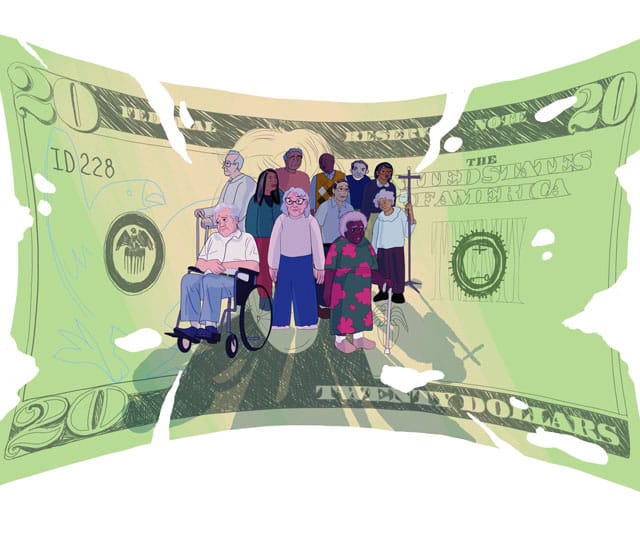More than 74 million Americans can expect a healthy inflation adjustment to their Social Security benefits next year — just not as large as this year’s historic 8.7% raise.
The recent slowdown in inflation points to a 2024 Social Security cost-of-living adjustment, or COLA, of around 3%, according to a forecast by the Senior Citizens League. That would still be higher than the average 2.6% adjustment over the past two decades, said Mary Johnson, a policy analyst for the league, a nonpartisan seniors’ organization.
“People need to be real — we just went through rates of inflation we haven’t seen in four decades,” she said. “A 3% COLA would be nothing to sneeze at.” Other estimates point to a possible raise of just over 3%.
The COLA is a crucial feature of Social Security that helps seniors and other beneficiaries keep up with inflation. The Social Security Administration will announce the COLA in October, after September inflation data is released. Beneficiaries will begin to receive the increases in January, but for retirees enrolled in Medicare, the amount of the raise will depend on one more number: the monthly Medicare Part B premium.
The premium for Part B (which covers outpatient services, like doctors’ visits) typically is deducted from Social Security benefits, and large increases can cut deeply into COLAs. Official word on the 2024 Part B premium won’t come until the fall, but Medicare’s trustees forecast a premium of $174.80 — an increase of 6%, or $9.90 per month, from the current standard. A 3% COLA would raise the average Social Security benefit of $1,788 by a little more than $53.60.
Under federal law, the COLA is calculated annually; Social Security averages together the figures for the consumer price index for Urban Wage Earners and Clerical Workers for the third quarter and compares that with the same averaged figures for the previous year. The COLA is the percentage difference between the two.
Social Security beneficiaries have experienced unusual volatility recently in the COLA and Part B premium changes. This year, the 8.7% adjustment was the largest in 40 years, and the Part B premium was reduced to walk back a 14.5% increase in 2022. It was the first time the premium fell in more than a decade.
In part, Medicare officials were aiming to recoup costs that went uncovered in 2021 after Congress capped the increase that year as a pandemic relief measure. But they also were building financial reserves to cover the expected cost of Aduhelm, a controversial, high-cost drug used to treat Alzheimer’s that the Food and Drug Administration approved. The drug would be covered under Part B because it is administered intravenously by health care providers. Medicare ultimately limited its availability, but the large premium increase in 2022 stuck.
The possible financial impact of another expensive drug surfaced with the recent FDA approval of Leqembi, an Alzheimer’s drug that has shown more promising results than Aduhelm.
Medicare will cover Leqembi under Part B for patients who qualify, although it will also require physicians to participate in a data-collection effort to monitor the drug’s effectiveness and risks. The manufacturer’s projected uptake for the drug is modest — 100,000 patients over the first three years of availability.
“It probably won’t have a substantial impact on the premium — at least not during 2024,” said Juliette Cubanski, deputy director of the program on Medicare policy at KFF, a nonprofit organization focused on health policy.
Some Alzheimer’s experts are not convinced that Leqembi will have meaningful benefits for patients, and there are concerns about side effects. Its cost, an expected $26,500 a year, not including related tests and doctors’ visits, may slow uptake.
Medicare Part B pays for 80% of covered services, with patients paying the remaining 20%. Patients using Leqembi who are enrolled in traditional Medicare paired with Medigap supplemental policies will have some or all of their copayments covered. Medicare patients without that protection would shoulder more than $5,000 in costs annually. That includes people on traditional Medicare who do not have Medigap policies and everyone enrolled in Medicare Advantage plans.
Advantage enrollees are responsible for the remaining 20% up to a cap specified by each plan. Last year, retirees could find themselves paying as much as $9,200 on average for in- and out-of-network services combined, according to KFF.
“There really is not a level playing field on cost-sharing protections across the two programs,” Cubanski said.
Some relief on the cost of prescriptions covered under Medicare Part D will come from the Inflation Reduction Act, which was signed into law last year. The law will protect seniors from high drug costs in two phases, starting in 2024 and culminating in 2025, when no enrollee will be required to pay more than $2,000 per year. The cap will be adjusted annually to reflect Part D spending growth.
There is no similar cap on drugs administered under Part B. But the law also empowers Medicare to negotiate drug prices with pharmaceutical companies under Part D (and, later, Part B), but that power will be phased in slowly and the long-term effect on drug prices remains uncertain.
A greater share of total Medicare spending has shifted from Part A (hospital care) to Part B — and not only because of the development of expensive medications. More health care is delivered in outpatient settings, including procedures such as joint replacements but also pricey new biologic drugs that patients cannot take at home.
The trend will put additional upward pressure on Part B spending, and premiums, in the years ahead.
“I don’t see a reason to think the trend will be reversed or stay at the level where it is now,” said Marilyn Moon, an economist and former trustee of both Social Security and Medicare.
A Squeeze for Lower-Income Retirees
A smaller Social Security COLA in 2024 will be especially challenging for people with lower benefits if it is paired with a substantial Part B premium increase, reducing the net increase to just 1% or 2%, or even possibly consuming all of a person’s additional payment. Low-income Medicare beneficiaries can receive help with costs through an array of programs that pay all or part of their premiums.
And a “hold harmless” provision in federal law prevents a reduction in a person’s Social Security benefits from one year to the next because of an increase in the Part B premium. In years of low COLAs or high Part B premium increases, people with smaller benefits have seen their payments remain flat.
Low-income elderly and disabled people who receive Supplemental Security Income benefits also receive the COLA, but their maximum benefit is only 75% of the income level that the United States defines as the official poverty line. The COLA won’t change that, since the poverty definition is adjusted annually for inflation, said David Weaver, a former associate commissioner in Social Security’s Office of Research, Demonstration and Employment Support.
African Americans feel the hardship of a below-poverty benefit more acutely, and they are three times as likely as white Americans to receive SSI, according to recent Census Bureau data.
Weaver and other advocates are pushing for changes to SSI that would raise benefits and improve access to the program.
“Years of discrimination have given us wide disparities in income and health outcomes by race,” he said. “They’re often discussed separately, but they often go hand in hand.”
c.2023 The New York Times Company. This article originally appeared in The New York Times.







